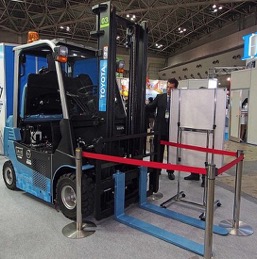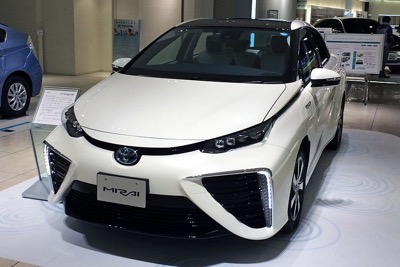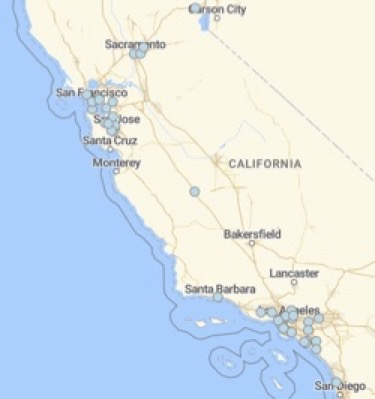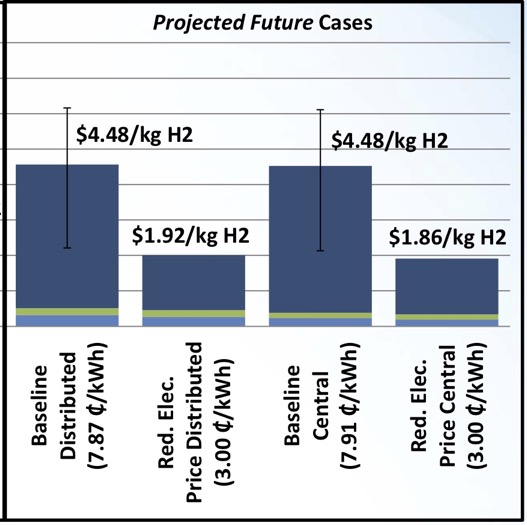Dinnerware Elevation
Hydrogen storage can be used to power transport vehicles. Two examples are forklifts, which are used to move large containers around, and automobiles, used to move large people around (large, at least, relative to their cats, who refuse to travel if they don’t feel like it).
According to the Department of Energy[1], about 30,000 hydrogen-powered electric forklifts have been sold in a total market of about 166,000 electric forklifts(64% of all forklifts) per year: if that were one year's sales, it would be around 20% of the market for electric products. In contrast, about 7,800 fuel cell automobiles have been sold, in a annual market of about 240,000 electric cars and 5.3 million cars of all sorts. Hydrogen-powered forklifts are a significant and growing share of all forklifts. Hydrogen powered automobiles are not. What’s the difference?


Figure 1: Toyota fuel-cell-powered forklift (left) and fuel-cell-powered car (right)
One piece is utility. Automobiles are (at least so far) still used a small fraction of the day by most people, and spend much of their existence parked either at their owner’s home, a retail establishment, or a place of work. It can be an inconvenience to wait a long time for an electric car to recharge, but in many cases that doesn’t affect its utility to its owner. Forklifts, on the other hand, are usually used inside large warehouses or industrial facilities. In the modern world many of these facilities run 24 hours a day, seven days a week. A hydrogen-powered forklift can be refueled in a few minutes. Batteries take hours to recharge, so they are swapped off the forklift and taken to a separate charging facility, often a logistical challenge.
The second piece is infrastructure. A giant warehouse is a big investment in people and facilities. Adding some storage for hydrogen is not cheap, but it is only a small part of the overall investment needed to operate such a facility. It’s not hard to convince a warehouse owner to make that investment if the benefit is substantial increases in utilization of the remainder of the money they put in. So hydrogen can be stored at the warehouse ready for use.
On the other hand, a person driving a car does not want to purchase their own huge storage tank, or drag it along with them when they travel. They expect to be able to find a refueling station, where they can refill their car at a nominal price. Electric car owners have the choice of about 20,000 conventional recharging stations, and about 1800 Tesla “supercharger” stations, as of 2019 [2]. People driving hydrogen cars have roughly 50 refueling stations in the United States, virtually all of them in urban California. And the current cost is on the order of $14/kg, equivalent to about three to four times the cost of a gallon of gasoline (pre-pandemic).

Figure 2: Hydrogen fueling stations in California.
There’s only one station between the San Francisco Bay Area and Los Angeles, which are separated by more than the range of a typical hydrogen car, the Mirai. Well, if you miss it but have a AAA card, you can always call for a tow truck. Even in Japan, the home of Toyota and Honda, only about 130 filling stations are currently operating [7].
We should note that this is not because hydrogen cars are intrinsically impractical. The cost of making hydrogen by electrolysis from renewable energy (which is also a very nice way to conveniently store energy that is not always generated when you need it) can easily reach an equivalent cost to gasoline, as shown by James et. al. [3]. The cost figures below are estimates for the cost of hydrolyzing water to hydrogen at small local ("distributed") locations, presumably close to the user, or large centralized locations perhaps farther away. The light blue at the bottom is the amortized capital cost, the green stripe above it is the cost of operating the plant, and the dark blue that dominates every column is the cost of electricity. If electricity is cheap (3 cents/kW-h) the cost of hydrogen can be as low as $2/kg. For reference, a kilogram of hydrogen is worth about 1.4 gallons of gas (if the gasoline-powered vehicle gets 45 mpg) so $4.48/kg is about like $3.20/gallon of gas, and $2/kg is $1.44/gallon of gas, the sort of price that used to apply when I had hair on the top of my head. If you can make it for $2 and sell it for $4 you're making a profit, and the buyer is still getting a good deal.

Figure 3: Estimated cost for hydrogen from hydrolysis of water, per James et. al. [3]
In the current small sales volumes, the Toyota Mirai lists for about $58,000, not cheap. But research indicates what you'd expect: this cost comes down a lot if you actually build and sell a reasonable number of cars. Huya-Kouadio et. al. [4] estimates that the cost of making a fuel-cell stack would fall from about $10,000 today to less than $2,000 at volumes of 100,000 per year. This savings alone, when we correct for a reasonable gross margin, would allow a list price similar to the Tesla model 3. So it should be possible to sell and run hydrogen-powered cars at prices generally comparable to today's gasoline-powered vehicles, all with a big reduction in carbon dioxide and other pollutants. What's the problem?
This is a standard case of what a physicist would recognize as a domain wall: a positive feedback interaction preventing transition to a different state. As long as few hydrogen-fueled vehicles are sold, the price remains high. But who wants to buy a vehicle that is hard to refuel? And as long as there are few vehicles, it’s not profitable to own a filling station, so no one will build them. A phase transition to another state doesn't happen magically everywhere: you don’t expect to install 50,000 unprofitable stations and suddenly sell 500,000 formerly-overpriced useless cars. You need a path, in this case a specific location where the requisite resources become sensible and the corresponding customers appear. That location will flip into the other state, where hydrogen is preferable and gasoline not. If barriers are not raised, the alternate state can spread to other locations and eventually become the global norm.
What are some possible paths? As noted, fuel-cell-powered forklifts are already commercially successful, even though energy density is almost completely irrelevant in this application. Their manufacture will help reduce the cost of fuel cell components, and hydrogen infrastructure installed to support them will also fall in cost, and become more familiar to people. Transit buses may then take over. Battery-powered electric buses already have a lower overall cost than diesel powered buses in some applications [5]. Fuel-cell buses become advantageous if a bus needs to travel long distances, where the low energy density per unit mass of a battery becomes a problem. Fuel cell buses also tolerate cold ambients better than batteries. And buses are expensive anyway, so the cost of the drive train is relatively less important. Those areas that choose to employ fuel cell buses will install hydrogen refueling infrastructure, again benefiting the overall availability of hydrogen refueling and people familiar with it. Finally, long-haul heavy trucks may transition to hydrogen, although here the cost of the hydrogen drive train is a substantial obstacle for many applications [6].
Getting to wide use of hydrogen in land transport is possible, but the path to get there isn't very straight.
